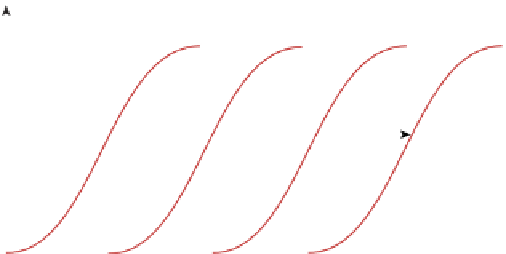Graphics Reference
In-Depth Information
100
Rods
Cones
0
0
7
Log luminance
D
Figure 28.8: The percent output of rods and cones. The rods' output flattens out at modest
luminance levels, and no change in output occurs even in very bright scenes; the cones'
response also flattens out, but the absolute position of the curve may vary along the log
luminance axis substantially as the cones adapt to the light present.
Among lights of constant brightness, there is considerable variation in spectral
power distribution: Those with greater power in the long wavelengths tend to
have one appearance; those with greater power in the short wavelengths have
another. We associate these appearances with the notions of “red” and “blue.”
Indeed, there's a whole vocabulary associated with describing color. Because it's
natural to think of color as an intrinsic property of surfaces or lights, and only
after a recognition of the mechanism of color perception is it clear that color is
in fact a perceptual phenomenon, most discussions of color talk about the colors
of objects, especially paints. We'll begin by introducing the terms used, and then
consider their meanings in light of our system view. Such terms as “hue,” “light-
ness,” “brightness,” “tints,” “shades,” “tones,” and “grays” are all used to describe
our perception of things.
Lightness
is used to describe surfaces, while
brightness
usually describes light sources.
Hue
is used to characterize the quality that we
describe with words like “red,” “blue,” “purple,” “aqua,” and so on, that is, the
quality that makes something appear to not be a blend of black and white. Blends
of black and white are called
grays;
blends of white and pure colors are called
tints,
while blends of black and pure colors are called
shades.
Colors that are
blends of black, white, and some pure color are called
tones
(see Figure 28.9).
(Properly speaking, we should say “The percepts arising from various combina-
tions of stimuli that produce the percepts 'black' and 'white' are called 'grays',”
but such language rapidly becomes fairly cumbersome.)
Tints
White
“Pure”
color
Tones
Shades
Grays
Black
Figure
28.9:
Tints,
tones,
and
shades,
as
commonly
used
to
describe colors.
What constitutes a “pure color,” though? Among all lights of a given lumi-
nance (monospectral or otherwise), we can form combinations by blending 50%
of one light with 50% of another, or blending with a 70:30 ratio, etc. Doing
so takes lights whose colors we've experienced and produces new ones, whose
colors may be new to us or may be ones we've experienced before. As we exper-
iment with more and more spectral power distributions, we find that certain dis-
tributions have colors that are “at the edge,” in the sense that they never appear as
the color of any combination of other spectra. Such colors can be called “pure.”
Indeed, experiment shows that such a designation of pure spectra leads to labeling











